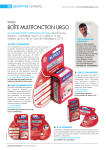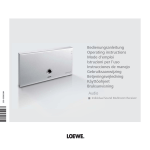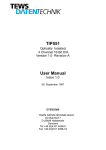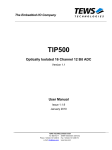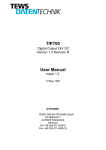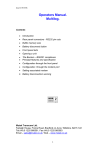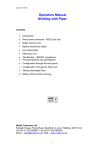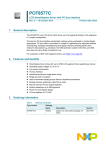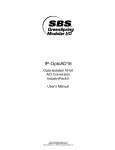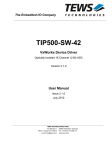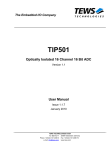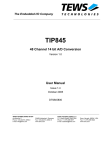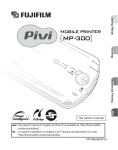Download TIP500 User Manual
Transcript
TIP500 Optically Isolated 16 Channel 12 Bit ADC Version 1.0 Revision A User Manual Issue 1.2 14. April 1999 D75500801 TEWS DATENTECHNIK GmbH Am Bahnhof 7 D-25469 Halstenbek Germany Tel +49 (0)4101 4058-0 Fax +49 (0)4101 4058-19 TIP500 User Manual Version 1.2 TIP500-10 optically isolated 16 channel 12 bit ADC input voltage range ±10V gain 1, 2, 5, 10 TIP500-11 optically isolated 16 channel 12 bit ADC input voltage range ±10V gain 1, 2, 4, 8 TIP500-20 optically isolated 16 channel 12 bit ADC input voltage range 0V to +10V gain 1, 2, 5, 10 TIP500-21 optically isolated 16 channel 12 bit ADC input voltage range 0V to +10V gain 1, 2, 4, 8 This manual covers all products This document contains information, which is proprietary to TEWS DATENTECHNIK GmbH. Any reproduction without written permission is forbidden. TEWS DATENTECHNIK GmbH has made any effort to ensure that this manual is accurate and complete. However TEWS DATENTECHNIK GmbH reserves the right to change the product described in this document at any time without notice. Issue Description 1.0 1.1 First issue 07. Feb. 1996 Technical Spec. 03. April 1996 TIP500 User Manual Version 1.2 Date This product has been designed to operate with IndustryPackX compatible carriers. Connection to incompatible hardware is likely to cause serious damage. TEWS DATENTECHNIK GmbH is not liable for any damage arising out of the application or use of the device described herin. K1996 by TEWS DATENTECHNIK GmbH IndustryPack is a registered trademark of GreenSpring Computers, Inc TIP500 User Manual Version 1.2 1. Product Description . . . . . . . . . . . . . . . . . . . . . . . . . . . . . . . . 5 2. Technical Specification . . . . . . . . . . . . . . . . . . . . . . . . . . . . 6 3. Functional Description . . . . . . . . . . . . . . . . . . . . . . . . . . . . . 7 3.1. Analog Input . . . . . . . . . . . . . . . . . . . . . . . . . . . . . . . . . . . . . . . . . . . . . 3.2. Data Correction . . . . . . . . . . . . . . . . . . . . . . . . . . . . . . . . . . . . . . . . . . . 3.2.1. ADC Correction Formula . . . . . . . . . . . . . . . . . . . . . . . . . . . . . . . . . . 7 8 8 4. ID Prom Contents . . . . . . . . . . . . . . . . . . . . . . . . . . . . . . . . . . 9 5. IP Addressing . . . . . . . . . . . . . . . . . . . . . . . . . . . . . . . . . . . . . . 13 5.1. ADC Register Set . . . . . . . . . . . . . . . . . . . . . . . . . . . . . . . . . . . . . . . 5.1.1. ADC Control Register Address $00 . . . . . . . . . . . . . . . . . . . . . . . . . 5.1.1.1. ADC Channel Selection . . . . . . . . . . . . . . . . . . . . . . . . . . . . . . . . . 5.1.1.2. ADC Gain Selection . . . . . . . . . . . . . . . . . . . . . . . . . . . . . . . . . . . . 5.1.1.3. ADC Automatic Settling Time Control . . . . . . . . . . . . . . . . . . . . . 5.1.1.4. ADC Pipeline Mode Control . . . . . . . . . . . . . . . . . . . . . . . . . . . . . . 5.1.1.5. ADC Interrupt Enable . . . . . . . . . . . . . . . . . . . . . . . . . . . . . . . . . . . 5.1.2. ADC Data Register Address $02 . . . . . . . . . . . . . . . . . . . . . . . . . . . 5.1.3. ADC Status Register Address $05 . . . . . . . . . . . . . . . . . . . . . . . . . 5.1.4. ADC Convert Start Register Address $07 . . . . . . . . . . . . . . . . . . . 5.1.5. Interrupt Vector Register Address $09 . . . . . . . . . . . . . . . . . . . . . . 5.1.6. ID Write Enable Register Address $0B . . . . . . . . . . . . . . . . . . . . . . 13 13 13 14 14 15 15 15 17 17 18 18 6. Operating Modes ................................................ 19 6.1. Mode Overview . . . . . . . . . . . . . . . . . . . . . . . . . . . . . . . . . . . . . . . . . . . 6.2. Automatic Mode . . . . . . . . . . . . . . . . . . . . . . . . . . . . . . . . . . . . . . . . . . 6.2.1. State Diagram Automatic Mode . . . . . . . . . . . . . . . . . . . . . . . . . . . . 6.2.2. Automatic Mode with Data Pipeline . . . . . . . . . . . . . . . . . . . . . . . . . 6.2.3. Automatic Mode without Data Pipeline . . . . . . . . . . . . . . . . . . . . . . 6.3. Normal Mode . . . . . . . . . . . . . . . . . . . . . . . . . . . . . . . . . . . . . . . . . . . . 6.3.1. State Diagram Normal Mode . . . . . . . . . . . . . . . . . . . . . . . . . . . . . . 6.3.2. Normal Mode with Data Pipeline . . . . . . . . . . . . . . . . . . . . . . . . . . . 6.3.3. Normal Mode without Data Pipeline . . . . . . . . . . . . . . . . . . . . . . . . 19 20 20 21 22 23 23 24 25 7. IP I/O connector . . . . . . . . . . . . . . . . . . . . . . . . . . . . . . . . . . . . 26 7.1. Analog Input Connections . . . . . . . . . . . . . . . . . . . . . . . . . . . . . . . . . . 7.2. Power Input Connections . . . . . . . . . . . . . . . . . . . . . . . . . . . . . . . . . . 26 27 TIP500 User Manual Version 1.2 Figure 1: TIP500 Block Diagram . . . . . . . . . . . . . . . . . . . . . . . . . . . . . . . . . Figure 2: ID PROM Contents TIP500-10 V1.0 . . . . . . . . . . . . . . . . . . . . . Figure 3: ID PROM Contents TIP500-11 V1.0 . . . . . . . . . . . . . . . . . . . . . Figure 4: ID PROM Contents TIP500-20 V1.0 . . . . . . . . . . . . . . . . . . . . . Figure 5: ID PROM Contents TIP500-21 V1.0 . . . . . . . . . . . . . . . . . . . . . Figure 6: CONTREG Input Channel Selection and Mode . . . . . . . . . . . . Figure 7: CONTREG Input Gain Selection . . . . . . . . . . . . . . . . . . . . . . . . Figure 8: CONTREG Automatic Settling Time Control . . . . . . . . . . . . . . Figure 9: CONTREG Pipeline Mode Control .......................................................... Figure 10: CONTREG Interrupt Enable . . . . . . . . . . . . . . . . . . . . . . . . . . . Figure 11: ADC Data Register . . . . . . . . . . . . . . . . . . . . . . . . . . . . . . . . . . . Figure 12: Data Register Description . . . . . . . . . . . . . . . . . . . . . . . . . . . . . Figure 13: ADC Status Register . . . . . . . . . . . . . . . . . . . . . . . . . . . . . . . . . Figure 14: INTVEC Interrupt Vector Register . . . . . . . . . . . . . . . . . . . . . . Figure 15: Operating Modes . . . . . . . . . . . . . . . . . . . . . . . . . . . . . . . . . . . . Figure 16: State Diagram Automatic Mode . . . . . . . . . . . . . . . . . . . . . . . . Figure 17: Flowchart Automatic Mode with Data Pipeline . . . . . . . . . . . . Figure 18: Flowchart Automatic Mode without Data Pipeline . . . . . . . . . Figure 19: State Diagram Normal Mode . . . . . . . . . . . . . . . . . . . . . . . . . . Figure 20: Flowchart Normal Mode with Data Pipeline . . . . . . . . . . . . . . Figure 21: Flowchart Normal Mode without Data Pipeline . . . . . . . . . . . Figure 22: TIP500 Analog Input Connections . . . . . . . . . . . . . . . . . . . . . . Figure 23: TIP500 Power Input Connections . . . . . . . . . . . . . . . . . . . . . . TIP500 User Manual Version 1.2 1 5 6 7 8 9 10 10 11 11 11 11 13 14 15 16 17 18 19 20 21 22 23 1. Product Description The TIP500 is an IndustryPack9 compatible module providing a galvanically isolated 16 channel multiplexed 12 bit ADC with on board DC/DC converter. Data acquisition and conversion time is mode dependent: up to 10 ³s without channel / gain change and up to 12.5 ³s with channel / gain change. The 16 input channels of the multiplexer can be configured by software to operate either in single ended mode or in differential mode with eight inputs. The multiplexer of the ADC circuit is over voltage protected up to 70 Vp-p. A programmable gain amplifier allows gains of 1, 2, 5, 10 (TIP500-10/-20) or 1, 2, 4, 8 (TIP500-11/-21) . The full scale input range is ±10V for the TIP500-10/-11 and 0V to 10V for the TIP500-20/-21 (for a gain of 1). E LW$' FRWHQYHU U ZLK6 W+ 3*$ JDLQ RU JDLQ FKDQQHO LQSXW P XOSWL H[HU ,' 32 05 '&'& FRWHQYHU U ,QGXVWU\3DFN ,2 LQWHUIDFH &RWUO RQ ,QWHIDFHU RSWRFRXSOHUV ,QGXVWU\3DFN ORJLF LQWHUIDFH Each TIP500 is calibrated at the factory. Calibration information is stored in the Identification PROM unique to each IP. Figure 1: TIP500 Block Diagram TIP500 User Manual Version 1.2 2. Technical Specification Logic Interface IndustryPack9 Logic Interface Size single wide IP I/O Interface 50-conductor flat cable Analog Inputs 16 single ended channels or 8 differential channels Input Isolation All channels are galvanically isolated from the IP Interface. DC/DC converter on board. Input Gain Amplifier Programmable for gain 1, 2, 5, 10 (TIP500-10 and TIP500-20) Programmable for gain 1, 2, 4, 8 (TIP500-11 and TIP500-21) Input Voltage Range TIP500-10: ±10V, ±5V , ±2V , ±1V , TIP500-20: 0V to 10V 0V to 5V 0V to 2V 0V to 1V (gain = 1) (gain = 2) (gain = 5) (gain = 10) TIP500-11: ±10V, ±5V, ±2.5V, ±1.25V, TIP500-21: 0V to 10V 0V to 5V 0V to 2.5V 0V to 1.25V (gain = 1) (gain = 2) (gain = 4) (gain = 8) Input Over Voltage Input over voltage protection up to 70V p-p Input ADC 12 bit ADC; data acquisition and conversion time up to 10³s without channel / gain change and up to 12.5³s with channel / gain change (mode dependent). Calibration Data Calibration data for gain and offset correction in ID PROM Accuracy ± 1LSB, after calibration for all TIP500 Modules. Linearity ± 1LSB for all TIP500 Modules Wait States IDSEL 1 wait state IOSEL 0 wait state INTSEL 0 wait state Power Requirements typ. 310 mA @ 5V Temperature Range Operating -40EC to 85EC Storage -45EC to 125EC Humidity 5 - 95% non-condensing TIP500 User Manual Version 1.2 3. Functional Description 3.1. Analog Input The TIP500 provides 16 single ended or 8 differential multiplexed analog inputs for. The desired input and the mode (single ended or differential) is selected by programming the input multiplexer. A software programmable gain amplifier with gain settings of 1, 2, 5 and 10 for the TIP500-10, -20 and 1, 2, 4 and 8 for the TIP500-11, -21 allows a direct connection of a wide range of sensors and instrumentation. The maximum analog input voltage range is ±10V at a gain of 1 for the TIP500-10 and TIP500-11. For the TIP500-20 and -21 the maximum analog input voltage range is 0V to 10V at a gain of 1. The ADC is a 12 bit ADS7808 with a maximum sample and conversion time of 10³s . The 12 bit data are alined in the bits 15-4 of a 16 bit data word, bits 3-0 are always zero. In multiplexed analog input systems a settling time must expire before the data can be converted after the change of the input channel. This settling time is depended on the programmed gain. At the most analog input solutions it is the responsibility of the user to observe the settling time. The TIP500 module has an Automatic Settling Time Control mode. If this mode is enabled, a write to the ADC Control Register, which is necessary to select a new input channel by the multiplexer, initiates a data conversion automatically after the settling time has expired. The absolute accuracy of the module is increased by using the possibility to correct the data by software with factory calibration factors, which are stored in the individual ID PROM of the module. TIP500 User Manual Version 1.2 3.2. Data Correction There are two errors which affect the DC accuracy of the ADC. The first is the zero error (offset). This is the data value when converting with the input connected with its own ground in single ended mode, or with shorted inputs in differential mode. This error is corrected by subtracting the known error from all readings. The second error is the gain error. Gain error is the difference between the ideal gain and the actual gain of the programmable gain amplifier and the ADC. It is corrected by multiplying the data value by a correction factor. The data correction values are obtained during factory calibration and are stored in the modules individual version of the ID PROM. The ADC has a pair of offset and gain correction values for each of the programmable gains. The correction values are stored in the ID PROM as two’s complement byte wide values in the range -128 to 127. For higher accuracy they are scaled to ¼ LSB. 3.2.1. ADC Correction Formula The basic formula for correcting any ADC reading for the TIP500-10 / -11 ( input voltage range +/- 10V ) is : Value = Reading * ( 1 - GainFRUU / 8192 ) - Offset FRUU * 4 The basic formula for correcting any ADC reading for the TIP500-20 / -21 ( input voltage range 0V to 10V ) is: Value = Reading * ( 1 - Gain FRUU / 16384 ) - Offset FRUU * 4 Value is the corrected result, Reading is the data read from the ADC, Gaincorr and Offsetcorr are the correction factors from the ID PROM. Gaincorr and Offsetcorr correction factors are stored for each for the possible gain settings. 1RWH )ORDWLQJ SRLQW DULWKPHWLFV RU VFDOHG LQWHJHU DULWKPHWLFV LV QHFHVVDU\ WR DYRLG URXQGLQJ HUURU ZKLOH FRPSXWLQJ DERYH IRUPXOD TIP500 User Manual Version 1.2 4. ID Prom Contents ADDRESS FUNCTION $ 01 $ 03 $ 05 $ 07 $ 09 $ 0B $ 0D $ 0F $ 11 $ 13 $ 15 $ 17 ASCII ’I’ ASCII ’P’ ASCII ’A’ ASCII ’C’ Manufacturer ID Model Number Revision RESERVED Driver-ID low-byte Driver-ID high-byte number of bytes used CRC $ 49 $ 50 $ 41 $ 43 $ B3 $ 18 $ 10 $ 00 $ 00 $ 00 $ 15 $ variable $ 19 Version -10 $ 0A $ 1B $ 1D $ 1F $ 21 $ 23 $ 25 $ 27 $ 29 Offset Error at Gain = 1 Offset Error at Gain = 2 Offset Error at Gain = 5 Offset Error at Gain = 10 Gain Error at Gain = 1 Gain Error at Gain = 2 Gain Error at Gain = 5 Gain Error at Gain = 10 $ board dependent $ board dependent $ board dependent $ board dependent $ board dependent $ board dependent $ board dependent $ board dependent $ 2B ...... $ 3F Not used $ 00 ....... $ 00 Figure 2: ID PROM Contents TIP500-10 V1.0 TIP500 User Manual Version 1.2 ADDRESS FUNCTION $ 01 $ 03 $ 05 $ 07 $ 09 $ 0B $ 0D $ 0F $ 11 $ 13 $ 15 $ 17 ASCII ’I’ ASCII ’P’ ASCII ’A’ ASCII ’C’ Manufacturer ID Model Number Revision RESERVED Driver-ID low-byte Driver-ID high-byte number of bytes used CRC $ 49 $ 50 $ 41 $ 43 $ B3 $ 18 $ 10 $ 00 $ 00 $ 00 $ 15 $ variable $ 19 Version -11 $ 0B $ 1B $ 1D $ 1F $ 21 $ 23 $ 25 $ 27 $ 29 Offset Error at Gain = 1 $ board dependent Offset Error at Gain = 2 $ board dependent Offset Error at Gain = 4 $ board dependent Offset Error at Gain = 8 $ board dependent Gain Error at Gain = 1 $ board dependent Gain Error at Gain = 2 $ board dependent Gain Error at Gain = 4 $ board dependent Gain Error at Gain = 8 $ board dependent $ 2B ...... $ 3F Not used $ 00 ....... $ 00 Figure 3: ID PROM Contents TIP500-11 V1.0 TIP500 User Manual Version 1.2 ADDRESS FUNCTION $ 01 $ 03 $ 05 $ 07 $ 09 $ 0B $ 0D $ 0F $ 11 $ 13 $ 15 $ 17 ASCII ’I’ ASCII ’P’ ASCII ’A’ ASCII ’C’ Manufacturer ID Model Number Revision RESERVED Driver-ID low-byte Driver-ID high-byte number of bytes used CRC $ 49 $ 50 $ 41 $ 43 $ B3 $ 18 $ 10 $ 00 $ 00 $ 00 $ 15 $ variable $ 19 Version -20 $ 14 $ 1B $ 1D $ 1F $ 21 $ 23 $ 25 $ 27 $ 29 Offset Error at Gain = 1 $ board dependent Offset Error at Gain = 2 $ board dependent Offset Error at Gain = 5 $ board dependent Offset Error at Gain = 10 $ board dependent Gain Error at Gain = 1 $ board dependent Gain Error at Gain = 2 $ board dependent Gain Error at Gain = 5 $ board dependent Gain Error at Gain = 10 $ board dependent $ 2B ...... $ 3F Not used $ 00 ....... $ 00 Figure 4: ID PROM Contents TIP500-20 V1.0 TIP500 User Manual Version 1.2 ADDRESS FUNCTION $ 01 $ 03 $ 05 $ 07 $ 09 $ 0B $ 0D $ 0F $ 11 $ 13 $ 15 $ 17 ASCII ’I’ ASCII ’P’ ASCII ’A’ ASCII ’C’ Manufacturer ID Model Number Revision RESERVED Driver-ID low-byte Driver-ID high-byte number of bytes used CRC $ 49 $ 50 $ 41 $ 43 $ B3 $ 18 $ 10 $ 00 $ 00 $ 00 $ 15 $ variable $ 19 Version -21 $ 15 $ 1B $ 1D $ 1F $ 21 $ 23 $ 25 $ 27 $ 29 Offset Error at Gain = 1 $ board dependent Offset Error at Gain = 2 $ board dependent Offset Error at Gain = 4 $ board dependent Offset Error at Gain = 8 $ board dependent Gain Error at Gain = 1 $ board dependent Gain Error at Gain = 2 $ board dependent Gain Error at Gain = 4 $ board dependent Gain Error at Gain = 8 $ board dependent $ 2B ...... $ 3F Not used $ 00 ....... $ 00 Figure 5: ID PROM Contents TIP500-21 V1.0 TIP500 User Manual Version 1.2 5. IP Addressing The TIP500 is controlled by a set of registers, which are directly accessible in the IO address space of the IP. ADDRESS NAME FUNCTION SIZE ACCESS $ 00 $ 02 $ 05 $ 07 $ 09 $ 0B CONTREG DATAREG STATREG CONVERT INTVEC IDWRENA ADC Control Register ADC Data Register ADC Status Register ADC Convert Start Register Interrupt Vector Register ID-PROM write enable word word byte byte byte byte R/W R/W RO WO R/W WO 1RWH ,':5(1$ LV IRU IDFWRU\ XVH RQO\ GR QRW ZULWH WR WKLV UHJLVWHU 5.1. ADC Register Set The ADC of the TIP500 is controlled by a set of 4 registers. All registers are cleared by IP_RESET. ADC Control Register ADC Data Register ADC Status Register ADC Convert Start Register 5.1.1. ADC Control Register Address $00 The ADC Control Register CONTREG is used to select an input channel, the gain and the mode for the next data conversion. This is done by writing the corresponding bit pattern into bit 0 to bit 9. ; ; ; ; ; ; unused bits access undefined access don’t care read write 5.1.1.1. ADC Channel Selection Bit 0 to bit 3 of the ADC Control Register CONTREG are used to select an input channel for the data conversion. Bit 4 of the ADC Control Register CONTREG is used to control if the module operates in differential or in single ended mode. If this bit is set to ’1’ differential mode is selected. Figure 6: CONTREG Input Channel Selection and Mode TIP500 User Manual Version 1.2 ' ) , &6 &6 &6 &6 ,QSXW &KDQQHO 6HOHFWLRQ 'LIIHUHQWLDO 6LQJOH (QGHG &+ &+ &+ &+ 'LIIHUHQWLDO 0RGH 1RWH ,Q GLIIHUHQWLDO PRGH RQO\ FKDQQHOV WR PD\ EH VHOHFWHG ,Q WKLV PRGH FKDQQHOV WR DUH XVHG DV LQSXW IRU FKDQQHOV WR 5.1.1.2. ADC Gain Selection Bit 5 and bit 6 of the ADC Control Register CONTREG are used to program the gain of the input amplifier. *$ 1 , *$ 1 , *DLQ 6HOHFWLRQ 7,3 7,3 * * * * * * * * Figure 7: CONTREG Input Gain Selection 5.1.1.3. ADC Automatic Settling Time Control If bit 7 of the ADC Control Register CONTREG is set to ’1’, the Automatic Mode for the settling time is enabled. In this mode a data conversion is initiated by writing to the ADC Control Register CONTREG, but however is automatically delayed by hardware until the gain depended settling time has expired. If bit 7 of the ADC Control Register CONTREG is set to ’0’, the Normal Mode for the settling time is enabled. In this mode a data conversion is initiated by writing to the ADC Convert Start Register CONVERT after selecting the desired channel and gain by writing to the ADC Control Register CONTREG. $6 7 &( $XWRPDWLF 6HWWOLQJ 7LPH &RQWURO (QDEOH Figure 8: CONTREG Automatic Settling Time Control TIP500 User Manual Version 1.2 1RWH 7KH VHWWOLQJ WLPH IRU DOO 7,3 0RGXOHV LV ³V IRU DOO JDLQV 5.1.1.4. ADC Pipeline Mode Control If bit 8 is set to ’1’ the pipeline mode is selected. In pipeline mode the result from the conversion (N-1) is shifted into the ADC Data Register DATAREG during the conversion N. 3 ,/ 3LSOLQH 0RGH VHOHFW Figure 9: CONTREG Pipeline Mode Control 5.1.1.5. ADC Interrupt Enable Bit 8 of the ADC Control Register CONTREG is used to enable interrupt generation of the module. If this bit is set to ’1’ interrupts are always initiated, whenever the settling time is over ( on IP_INTREQ1 ) and data conversion has been completed ( on IP_INTREQ0 ). If the module is in the automatic mode ( bit7 set to ’1’ ) only one interrupt at the end of data conversion ( on IP_INTREQ0 ) is being generated. 1 ,7 (1$ ,QWHUUXSW (QDEOH Figure 10: CONTREG Interrupt Enable 5.1.2. ADC Data Register Address $02 The ADC Data Register DATAREG contains the converted data value. The 12 bit ADC value is shifted in the higher bit’s of the data register by hardware . This allows direct processing of the data as a 16 bit two’s complement integer value for the TIP500-10/11 and 16 bit straight binary for TIP500-20/21. ELW $'& GDWD Figure 11: ADC Data Register Figure 12: Data Register Description TIP500 User Manual Version 1.2 ',*,7$/ 287387 '(6&5,37,21 ELQDU\ WZR V FRPSOHPHQW 7,3 )XOO 6FDOH )6 /6% 0LGVFDOH 2QH /6% %HORZ 0LGVFDOH )XOO 6FDOH )) ))) VWUDLJKW ELQDU\ 7,3 ))) )) 1RWH 7KH FRQWHQWV RI $'& 'DWD 5HJLVWHU '$7$5(* LV QRW YDOLG DV ORQJ DV WKH $'& %XV\ )ODJ LV UHDG DV TIP500 User Manual Version 1.2 5.1.3. ADC Status Register Address $05 Bit 0 and bit 1 of the ADC Status Register STATREG reflect the status of the ADC converter. As long as bit 0 is read as ’1’, the settling time did not expire after writing to the ADC Control Register CONTREG. Bit 1 indicates the busy status of the ADC converter itself ( ’1’ = ADC busy ). If Automatic Mode is active bit 1 indicates a ’1’ during the settling time and the conversion time. $ ' & % XV\ 6 HWOW % XV\ 6HWWOLQJ 7LPH %XV\ $'& %XV\ Figure 13: ADC Status Register 1RWH %LW RI WKH $'& 6WDWXV 5HJLVWHU DUH XQGHILQHG 5.1.4. ADC Convert Start Register Address $07 If the TIP500 is configured in Normal Mode writing any value into the ADC Convert Register CONVERT starts a data conversion immediately. 1RWH ,Q QRUPDO PRGH LW LV LQ WKH UHVSRQVLELOLW\ RI WKH XVHU WR REVHUYH WKH VHW WOLQJ WLPH EXV\ IODJ DQG WKH $'& EXV\ IODJ RI WKH $'& 6WDWXV 5HJLVWHU :ULWHV WR WKH $'& &RQYHUW 6WDUW 5HJLVWHU &219(57 GXULQJ $'& EXV\ DUH LJQRUHG TIP500 User Manual Version 1.2 5.1.5. Interrupt Vector Register Address $09 The Interrupt Vector Register INTVEC is a byte wide read/write register. The Interrupt Vector Register is shared between both interrupt sources, but both, the settling time ready and the ADC data ready will create an individual interrupt. A read cycle to the INTVEC Register acknowledges and clears the interrupt. ; :LOO UHDG DW LQWHUUXSW DV IRU $'& GDWD UHDG\ IRU VHWWOLQJ WLPH UHDG\ ,QWHUUXSW YHFWRU ORDGHG E\ VRIWZDUH Figure 14: INTVEC Interrupt Vector Register For an interrupt from settling time ready bit 0 of the interrupt vector will read as ’1’. For an interrupt from the ADC data ready bit 0 will read as ’0’. If the vector register is for example loaded with ’$60’, settling time ready will create an interrupt at vector ’$61’ and ADC data ready will create an interrupt at vector ’$60’. 1RWH 7KH LQWHUUXSW VHWWOLQJ WLPH UHDG\ LV FUHDWHG E\ WKH IDOOLQJ HGJH RI VHWWOLQJ WLPH EXV\ VWDWXV DQG XVHV WKH ,175(4 WKH LQWHUUXSW $'& UHDG\ LV FUHDWHG E\ WKH IDOOLQJ HGJH RI $'& EXV\ VWDWXV DQG XVHV WKH ,175(4 LQWHUUXSW OLQH RI WKH ,3 EXV 5.1.6. ID Write Enable Register Address $0B This register is for factory use only. Do not write to this register. If bit 0 is set ’1’ a write access to the ID-PROM is enabled. TIP500 User Manual Version 1.2 6. Operating Modes The TIP500 supports four operating modes which are selected with bit 7 ( Normal / Automatic Mode ) and bit 8 ( Pipeline / no Pipeline Mode ) of the ADC Control Register CONTREG. 6.1. Mode Overview - 1RUPDO 0RGH 1R 3LSHOLQH 0RGH - $XWRPDWLF 0RGH 1R 3LSHOLQH 0RGH - 1RUPDO 0RGH 3LSHOLQH 0RGH - $XWRPDWLF 0RGH 3LSHOLQH 0RGH CONTREG Bit 7 = 1 CONTREG Bit 7 = 0 Automatic Mode Normal Mode After the settling time has expired conversion CONTREG Bit 8 = 1 N is started and the result of conversion Pipline Mode N-1 is shifted into the ADC Data Register. A write access to the CONVERT register starts conversion N and shifts the result of conversion N-1 into the ADC Data Register. After the settling time has expired conversion CONTREG Bit 8 = 0 N is started and the result of conversion N is shifted into the ADC No Pipline Mode Data Register. A write access to the CONVERT register starts conversion N and shifts the result of conversion N into the ADC Data Register. Figure 15: Operating Modes 1RWH ,Q 1RUPDO 0RGH WKH XVHU VKRXOG REVHUYH WKH VHWWOLQJ WLPH E\ WKH VHWWOH EXV\ IODJ LQ WKH $'& 6WDWXV 5HJLVWHU TIP500 User Manual Version 1.2 6.2. Automatic Mode The Automatic Mode is enabled by setting bit 7 of the ADC Control Register CONTREG to ’1’. A write access to the ADC Control Register CONTREG with bit 7 set to ’1’ start a conversion for the programmed channel and gain after the settling time has expired. In Pipeline Mode ( bit 8 of the ADC Control Register CONTREG set to ’1’ ) the result of the previous conversion is shifted into the ADC Data Register DATAREG during the actual conversion. If the Pipeline Mode is switched off the result of the actual conversion is shifted into the ADC Data Register DATAREG. 6.2.1. State Diagram Automatic Mode QR F\FOH QH[W $'& EXV\ $'& EXV\ 5(6(7 ,'/( ZULWH DFFHVV WR &2175(* %86< Figure 16: State Diagram Automatic Mode In Automatic Mode the ADC busy flag is active during the whole cycle of channel/gain select, settling time and data conversion. When the ADC busy flag becomes inactive ( = ’0’ ) the conversion result is accessible in the ADC Data Register DATAREG and an interrupt will be generated if interrupts are enabled. TIP500 User Manual Version 1.2 6.2.2. Automatic Mode with Data Pipeline If Automatic Mode with Pipeline is selected during conversion N the result of conversion N-1 is shifted into the ADC Data Register DATAREG. The acquisition and conversion time in this mode is 20³s. 67$57 Write access to the ADC Control Register starts automatically the conversion N after the settling time has expired and shifts the result of conversion N-1 into the ADC Data Register. select new gain & channel Auto & Pipeline active Bit1 of the ADC Status Register indicates ADC busy during the whole cycle. ADC BUSY " \ Q read data of conversion N-1 Read data of the conversion N-1 from ADC Data Register Figure 17: Flowchart Automatic Mode with Data Pipeline TIP500 User Manual Version 1.2 6.2.3. Automatic Mode without Data Pipeline If Automatic Mode without Pipeline is selected the result of the actual conversion is shifted into the ADC Data Register DATAREG. The acquisition and conversion time in this mode is 30³s. 67$57 Write access to the ADC Control Register starts automatically the conversion after the settling time has expired and shifts the result into the ADC Data Register. select new gain & channel Auto active Bit1 of the ADC Status Register indicates ADC busy during the whole cycle. ADC BUSY " \ Q read data of conversion (n) Read data of the actual conversion from the ADC Data Register Figure 18: Flowchart Automatic Mode without Data Pipeline TIP500 User Manual Version 1.2 6.3. Normal Mode The Normal Mode is enabled by setting bit 7 of the ADC Control Register CONTREG to ‘0‘. A write access to the ADC Control Register CONTREG with bit 7 set to ’0’ ( Normal Mode enabled ) selects a new channel and gain for the next conversion. As long as the settling time expires bit 0 of the ADC Status Register STATREG ( settle busy flag ) reads as ‘1‘. After the settling time has expired a conversion can be started by writing to the ADC Convert Start Register CONVERT. To achieve higher conversion rates it is possible to select a new channel and gain for the next conversion after the previous conversion has been started. In this mode the settling time for the new channel and the conversion time of the actual channel proceed simultaneously. As long as bit 1 of the ADC Status Register STATREG ( ADC busy flag ) reads as ‘1‘ conversion is in progress. Reading bit 1 of the ADC Status Register as ‘0‘indicates that the conversion result is accessible in the ADC Data Register DATAREG. If interrupts are enabled two interrupts will be generated: the first interrupt at the end of the settling time, the second interrupt at the end of conversion. 6.3.1. State Diagram Normal Mode $'& EXV\ 6HWWOH EXV\ 6(77/(B %86< $'& %86< $ & % ' 5(6(7 ,'/( $ :ULWH DFFHVV WR &2175(* % 6HWWOLQJ WLPH H[SLUHG & :ULWH DFFHVV WR &219(57 ' $'& UHDG\ FRQYHUVLRQ UHVXOW LQ $'& 'DWD 5HJLVWHU QR F\FOH QH[W Figure 19: State Diagram Normal Mode TIP500 User Manual Version 1.2 6.3.2. Normal Mode with Data Pipeline If Normal Mode with Pipeline is selected during conversion N the result of conversion N-1 is shifted into the ADC Data Register DATAREG. In this mode it is possible that the settling time and conversion time simultaneous proceed. The acquisition and conversion time in this mode is 10³s with no change of channel / gain and 12.5³s with change of channel / gain. 67$57 :ULWH DFFHVV WR $'& &RQWURO 5HJLVWHU select gain & channel Pipeline active Read bit 0 of ADC Status Register to check for end of settling time. SETTLE BUSY " \ Q Write access to ADC Start Convert Register starts conversion N and shifts result of conversion N-1 into the ADC Data Register. VWDUW FRQYHUVLRQ Select a new channel and a new gain during conversion proceeds by a write access to the ADC Control Register. select new gain & new channel Pipeline active ADC BUSY " \ Read bit1 of the ADC Status Register to check for end of conversion. Q read data of conversion N-1 Read result of the conversion N-1 from ADC Data Register. Figure 20: Flowchart Normal Mode with Data Pipeline 1RWH )RU FRQYHUVLRQV ZLWKRXW FKDQQHO DQG JDLQ FKDQJH LW LV QRW QHFHVVDU\ WR REVHUYH WKH VHWWOH EXV\ IODJ RI WKH $'& 6WDWXV 5HJLVWHU TIP500 User Manual Version 1.2 6.3.3. Normal Mode without Data Pipeline If Normal Mode without Pipeline is selected the result of the actual conversion is shifted into the ADC Data Register DATAREG. In this mode it is possible that the settling time and conversion time simultaneous proceed. The acquisition and conversion time in this mode is 20³s. 67$57 :ULWH DFFHVV WR $'& &RQWURO 5HJLVWHU select gain & channel Read bit 0 of ADC Status Register to check for end of settling time. SETTLE BUSY " \ Q Write access to ADC Start Convert Register starts conversion and shifts result of conversion into the ADC Data Register. VWDUW FRQYHUVLRQ Select a new channel and a new gain during conversion proceeds by a write access to the ADC Control Register. select new gain & channel ADC BUSY" \ Read bit1 of the ADC Status Register to check for end of conversion. Q read data of conversion Read result of the conversion from ADC Data Register. Figure 21: Flowchart Normal Mode without Data Pipeline 1RWH )RU FRQYHUVLRQV ZLWKRXW FKDQQHO DQG JDLQ FKDQJH LW LV QRW QHFHVVDU\ WR REVHUYH WKH VHWWOH EXV\ IODJ RI WKH $'& 6WDWXV 5HJLVWHU TIP500 User Manual Version 1.2 7. IP I/O connector 7.1. Analog Input Connections Pin-Number Mode Single Ended Differential 01 02 03 04 05 06 07 08 09 10 11 12 13 14 15 16 17 18 19 20 21 22 23 24 ADC Input 1 ADC Input 9 AGND ADC Input 10 ADC Input 2 AGND ADC Input 3 ADC Input 11 AGND ADC Input 12 ADC Input 4 AGND ADC Input 5 ADC Input 13 AGND ADC Input 14 ADC Input 6 AGND ADC Input 7 ADC Input 15 AGND ADC Input 16 ADC Input 8 AGND ADC Input 1 + ADC Input 1 AGND ADC Input 2 ADC Input 2 + AGND ADC Input 3 + ADC Input 3 AGND ADC Input 4 ADC Input 4 + AGND ADC Input 5 + ADC Input 5 AGND ADC Input 6 ADC Input 6 + AGND ADC Input 7 + ADC Input 7 AGND ADC Input 8 ADC Input 8 + AGND Figure 22: TIP500 Analog Input Connections TIP500 User Manual Version 1.2 7.2. Power Input Connections Pin-Number Function 44 45 46 47 48 49 50 AGND -15V AGND +15V AGND +5V AGND Figure 23: TIP500 Power Input Connections 1RWH 7KH SRZHU LQSXW FRQQHFWLRQV DUH UHVHUYHG IRU VSHFLDO YHUVLRQV RI WKH 7,3 ZLWKRXW RQ ERDUG '&'& FRQYHUWHU TIP500 User Manual Version 1.2





























